
- Source: ArtNet News
- Author: Janelle Zara
- Date: March 5, 2021
- Format: Digital
Meet Artist Kandis Williams, Whose Poetic Work Has a Sharp, Cerebral, and Radically Political Edge
Williams weaves through histories and unearths long ignored narratives.
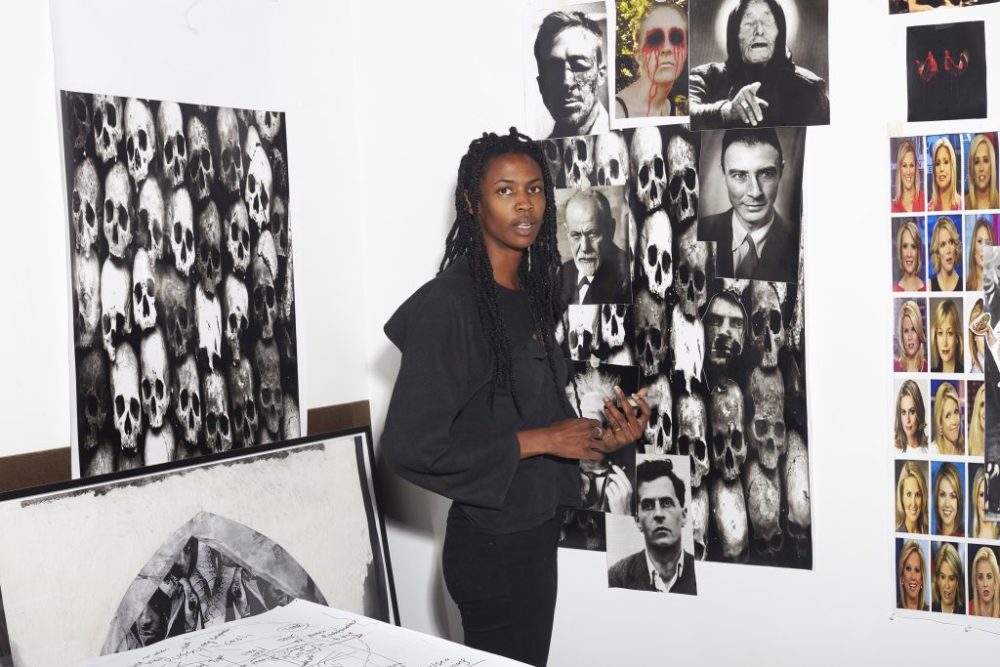
Kandis Williams. Photo: Dicko Chan, 2018.
At the center of Kandis Williams’s first solo institutional show, “A Field,” on view at Virginia Commonwealth University’s Institute for Contemporary Art through August 1, a full-sized greenhouse is shrouded in sculptures of exotic plants. Inside, the artist’s 2020 video, Annexation Tango, depicts a dancer’s body floating over aerial shots of Virginia farms and California forest fires. Superimposing a dance born in the spiritual traditions of enslaved Africans over two sites that have been respectively tilled and extinguished by incarcerated people, the seemingly disparate footage illustrates a recurring theme in Williams’s recent bodies of work: the enduring link between the cultivation of plant life in the New World and forced labor.
“Plants are dynamic containers to describe the human condition,” Williams told me over Google Meet, proficiently rolling tobacco into a tidy cigarette. During the most recent Hammer Biennial, her work used the exportation of plants as a resonant parallel to the violent uprooting of the transatlantic slave trade. Presented at the sprawling Huntington Gardens, where 100,000 or so foreign specimens unable to take root had died, her portrait of the gardens’ founder, 20th-century oil magnate Henry Huntington, combined his face with that of Goya’s ravenous Saturn Devouring His Son.
Her focus on plants, she said in her artist’s statement, “was putting another life into the equation to deal with structural racism.” In admiration of a plant’s resilience in unnatural containers, she added: “It’s going to resist or it’s going to fade.”
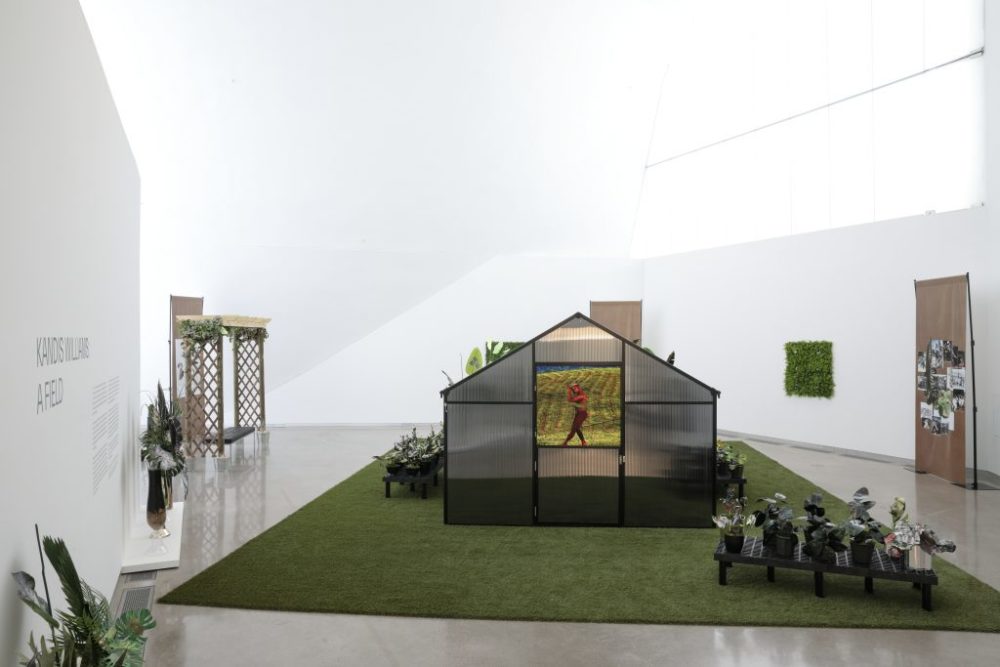
Installation image, “Kandis Williams: A Field” at the Institute for Contemporary Art at Virginia Commonwealth University, 2020.
Photo: David Hale.
The Collage Brain
A piece by Kandis Williams is a composite: layered photographs, footage, and texts that bring the past and present into simultaneous focus. Through Cassandra Press, the platform for Black Feminist scholarship that she co-founded in 2016, the artist publishes readers, multi-author deep dives into Black Twitter, double consciousness, and various other topics churning inside her mind.
Williams’s practice is driven by her “collage brain,” she said, a systematic impulse to deconstruct and reconstruct narratives and images. Her process begins with immersive research, the steady consumption of historical literature, critical theory, and the often addictive discourse unfolding over TikTok. Unpeeling the layers of a flattened official record, she mines for recurring patterns, connective tissue, and details that have been suppressed. She reassembles the two-dimensional into a work of greater depth, whether in the form of video, collage, reader, or performance.
“We can look at Romare Bearden collages and think about the ways that he was similarly thinking about dispossession and the body,” says VCU’s Amber Esseiva, curator of “A Field.” But for her, there’s no precise comparison for the work that Williams does.
“She has this way of identifying logics within various forms of information, theory, and histories,” she added, “which for me is pretty unprecedented.”
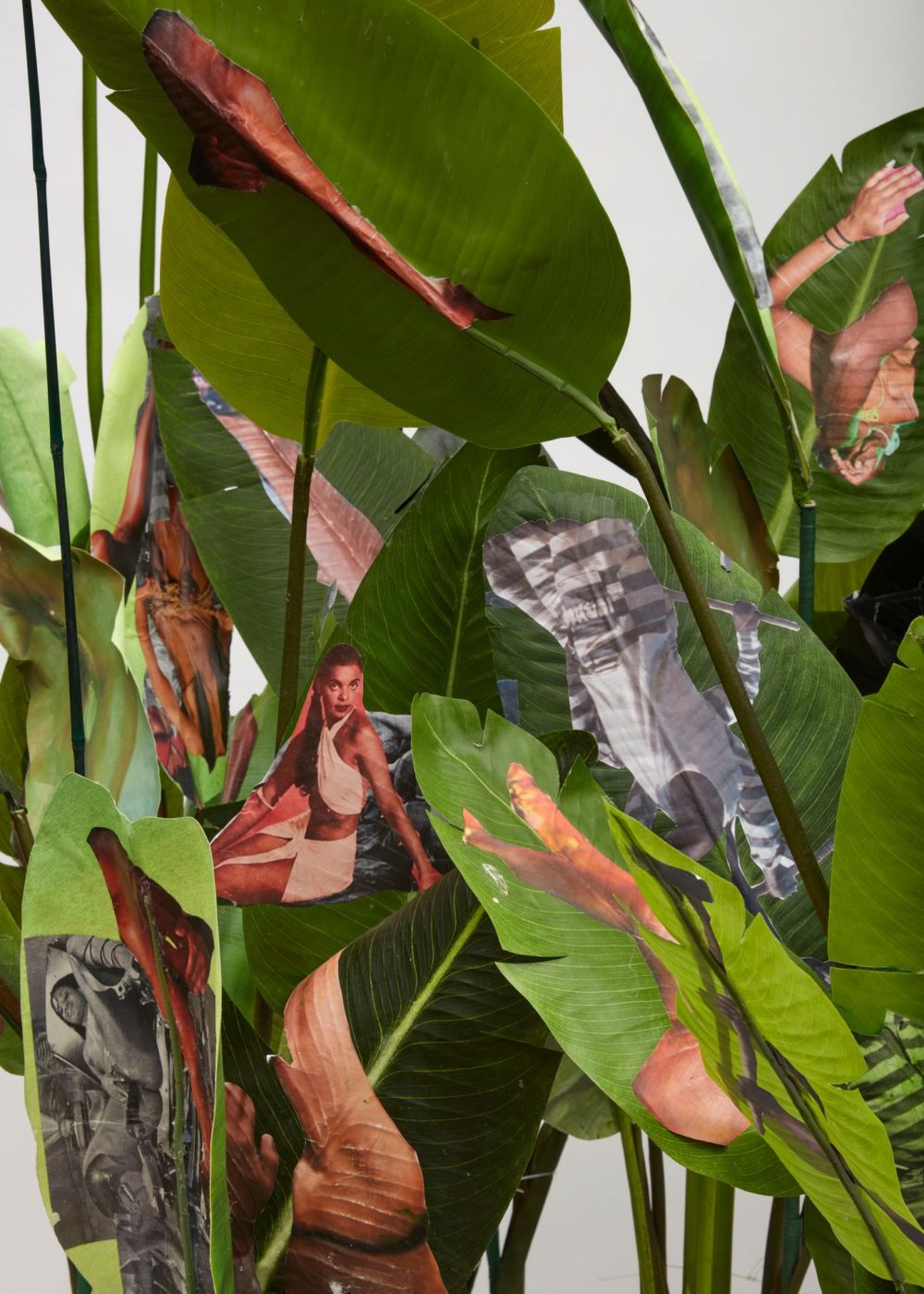
Courtesy of Kandis Williams and Night Gallery, Los Angeles. Photo: Paul Salveson.
An Unprecedented Year
“It wasn’t so easy to be an artist that hopped around in different mediums or materials,” Williams told me, recalling the traumatizing critiques of early studio visits: “The work is too scary,” she was told. “There’s too many words.”
Over the years, however, the response to Williams’s work has evolved, with 2020 marking a landmark moment in her poetic, intensely cerebral practice. Her first institutional show coincides with a surge in activity for Cassandra Press, which, with newfound nonprofit status, used the rise of Zoom learning as an opportunity to open online classrooms. The artist was in Zurich when we spoke, working with the nonprofit Luma Westbau on the release of 12 forthcoming Cassandra Press readers.
“We have an encyclopedia of Blackness and abstraction,” she said, alongside a primer on the conventions of Noh theater and biographies of various plants—tobacco, calla lily, and other species that have thrived in the wake of involuntary export.
Momentarily crossing over into fashion last year, Williams also took on the role of dramaturgist for “Peculiar Contrast, Perfect Light,” a short film for Louis Vuitton’s latest menswear presentation. (Coincidentally, the project was inspired by “Stranger in the Village,” James Baldwin’s 1953 essay on being Black in Switzerland.)
“Her personality added a valuable sentiment into the granular details of the film—Black experience injected into the bloodstream of the piece, almost in a coded language,” said Louis Vuitton Men’s artistic director Virgil Abloh. “Kandis rigorously grounds her practice in Black expression, but wears her heart on her sleeve.”
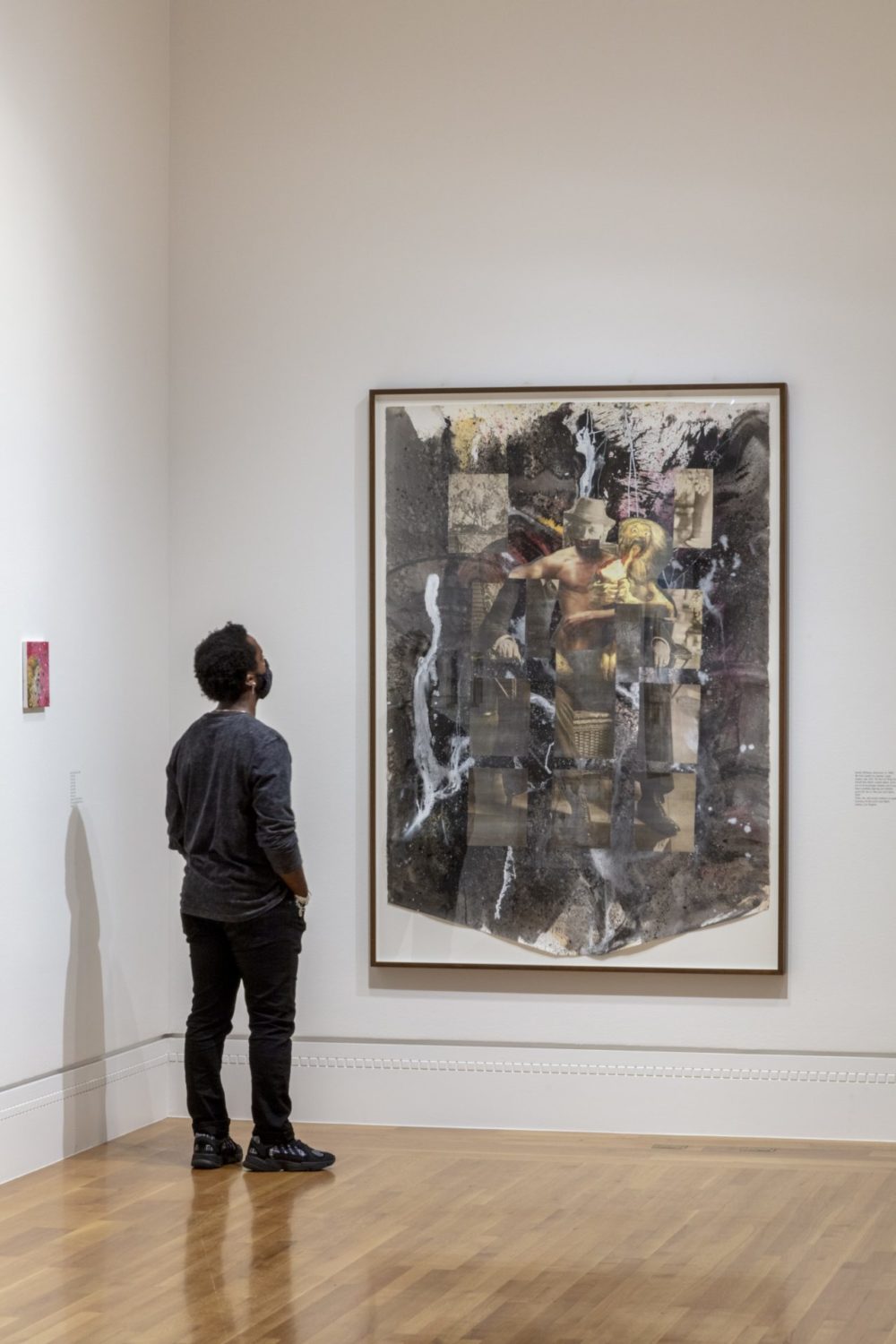
A work by Kandis Williams at the Huntington Library, Art Museum, and Botanical Gardens. Photo: Joshua White.
Stranger in the Village
Before moving to Los Angeles after a 12-year stint in Berlin, Williams was born and raised in Baltimore, a majority-Black, deindustrialized city burdened by manifold forms of institutional violence. In its “constant transmutation of individual trauma into a cultural wellspring,” she said, Baltimore shaped both her worldview and her understanding of art. “It always had a strong Black creative community, an agential Black culture with a voice.”
When she was accepted into Cooper Union’s BFA program, Williams initially felt cautious optimism about art school, which quickly gave way to disillusionment and burnout. In contrast to the art-making of her upbringing, “Art with a capital A,” she said, proved to be a more rigid apparatus, one that discreetly upholds systems of white supremacy.
“There are so many white lies in the canon,” the artist explained. “The term whitewashing doesn’t even describe it.” Its flattened account of history serves as a type of Eurocentric propaganda, she added, describing the erasure of the art and ritual processes of other cultures. (Consider the uncredited Africans who created the tango, for example.) The art world’s predetermined categories, additionally, were especially alienating for an artist working across different media. “It was like this fetish object of the Black painter was the only real expression of being a Black artist,” she said
Cassandra Press later emerged as a dynamic container for the machinations of her collage brain, and as an artistic practice of Williams’s own design. The press’s readers and new online class offerings, including David Zwirner director Ebony Haynes’s commercial art primer for Black students only, provides space—space to explore alternative canons, and to create “our own personal lineages and professional legacies,” Williams said.
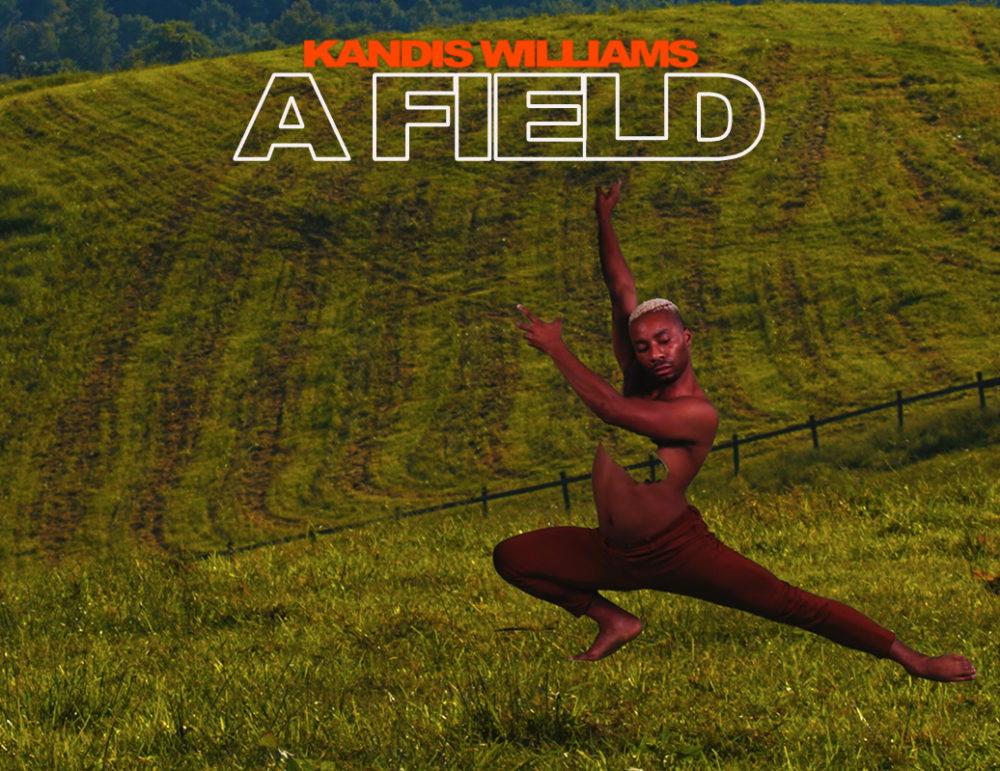
Kandis Williams, still from Annexation Tango (2020).
Alternative Canons
The fetishization of the Black painter still very much persists, but following the murders of George Floyd and Breonna Taylor last summer, culture at large underwent an electrifying change in attitude. “The uprising in between definitely sparked, for better or for worse,” Williams told Artists 4 Democracy, “both a superficial and a really intense, welcomed look at Black projects, Black creative space, Black intellectual space.”
Williams’s 2021 schedule is filling up, with a Los Angeles solo show planned for Night Gallery in June, and shows with two major institutions yet to be announced. Cassandra Press is now “full steam ahead,” she said, with project proposals streaming in from various archives, and a new children’s imprint with homeschooling resources for Black parents on the way. Teaching children was what restored Williams’s relationship with artmaking in the years after graduating from art school; the earnestness with which they could transform their emotions into material substance, she said, “gave art back to me.”
Cassandra, an oracle of Greek mythology, is an apt metaphor for the unheard Black radical Feminist voice. According to legend, she had prophesied the fall of Troy, but, cursed to never be believed, went wholly ignored. In the context of 2021, as more marginalized peoples are finding their overdue recognition, Cassandra’s prophecies sound less like predictions of the future than an acute awareness of what was happening around her.
“It just feels like reading the signs and understanding the present,” Williams said. “That’s the root of so many different marginal practices.”

